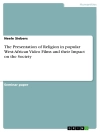Seminar paper from the year 2004 in the subject Ethnology / Cultural Anthropology, grade: 1, University of Vienna (Calpoly Thai Study Program 2004), language: English, abstract: I am writing this paper on the Thai nation state and its minorities as a student of political sciences as well as social and cultural anthropology, educated at the University of Vienna. Through a short period I had the chance to study Thai culture in the country itself but this is not given me enough proficiency to judge the same. On my research I rely on scholars which have had wide range of vast experiences with the country, nevertheless I try to implement my own experiences in a, as far as it is possible, objective way.
Since 1939 Thailand exists, but only the name itself appeared then as Siam, its former name was known already hundreds of year, back to its traditional founding date in 1238 (CIA Factbook, Winichakul 1994:150). The difference between Siam and Thailand is the form of its organization, as Siam was always a monarchy ruled by an absolute monarch. Only 1932 this absolute monarchy became history and a new form of state was born. From there on we speak of Thailand – a modern nation state (Mc Cargo 2000). As Thongchai Winichakul writes was this change a political act of a chauvinist regime to promote the domination of the ethnic Thai and their culture over others. The Thai government under Phibun (1939-1944) had adopted to fascism, which was a global current during this time, they promoted the notion of the great Thai race and their territory (Winichakul 1994:18, 150).
The following paper is going to deal with this concept of the Thai state during the major part of the last century, describing the challenges the western concept brought with it, especially in terms of ethnicity. Thailand was formed with nationalistic ideas, in a territorial as well as an ethnic way, whereas the latter was natural due to the fact that, as nowadays, 95% of the Thai citizens define themselves as ethnic Thai’s – including Isarn and Lanna (see 2.3). At the beginning of the nation this did not look as clear as it seams. As a part of the heterogeneous South East Asia also the territory of Thailand is inhabited by a wide ethnic divergence. Thailand itself brought many Chinese immigrants into the country, as workers adding to their economic boom. Where are they now? And much more interesting what are they now?
Sabine Putzgruber
Ethnic groups in Thailand – A study of minority groups within the Thai nation state involving ethnic Chinese, Muslims and Highland Peoples [EPUB ebook]
Ethnic groups in Thailand – A study of minority groups within the Thai nation state involving ethnic Chinese, Muslims and Highland Peoples [EPUB ebook]
قم بشراء هذا الكتاب الإلكتروني واحصل على كتاب آخر مجانًا!
لغة الإنجليزية ● شكل EPUB ● صفحات 42 ● ISBN 9783638508254 ● حجم الملف 0.6 MB ● الناشر GRIN Verlag ● مدينة München ● بلد DE ● نشرت 2006 ● الإصدار 1 ● للتحميل 24 الشهور ● دقة EUR ● هوية شخصية 3781959 ● حماية النسخ بدون












